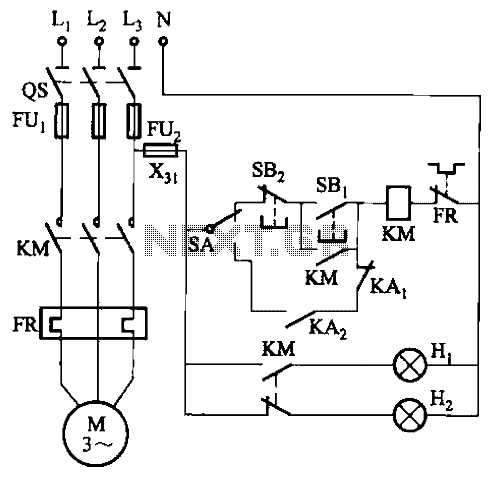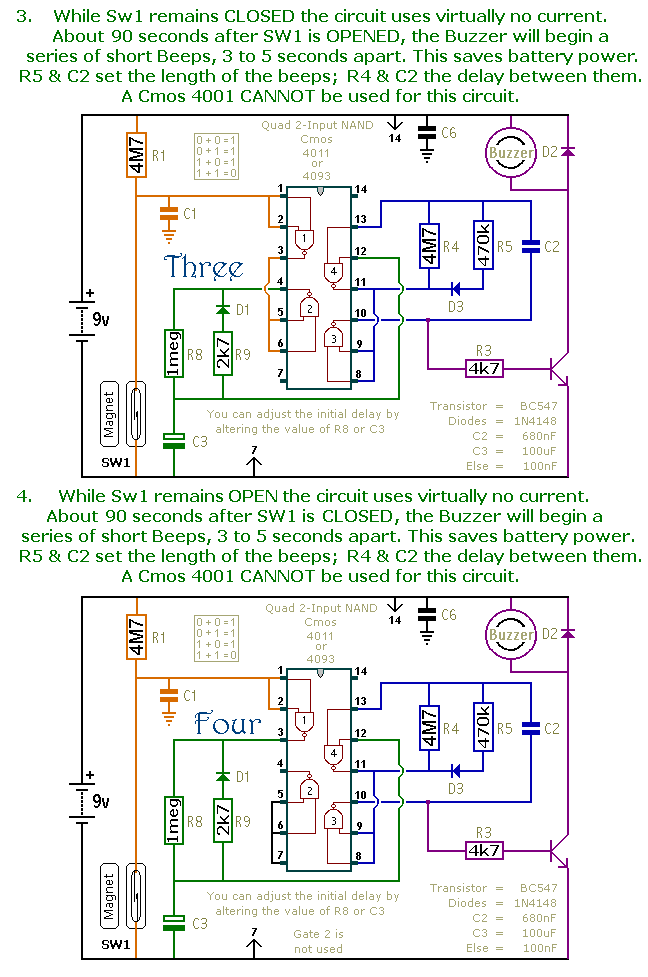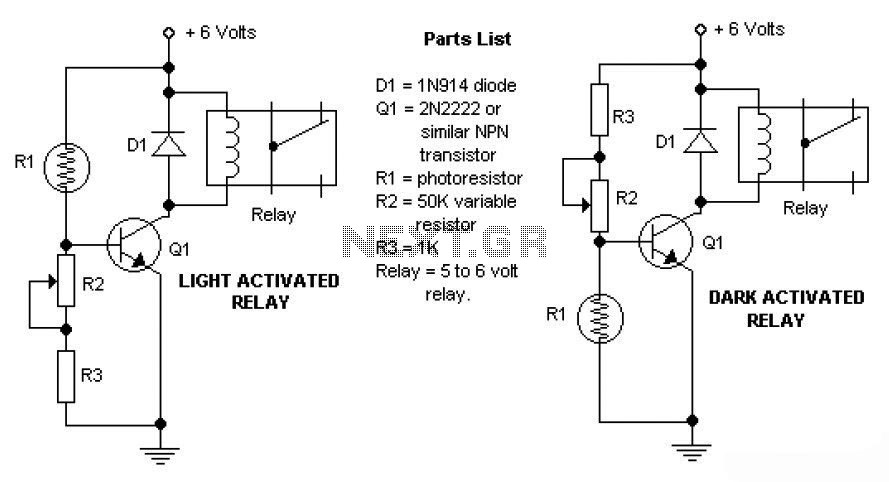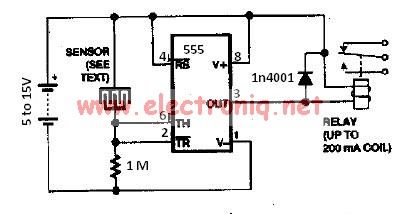
Water Activated Alarm
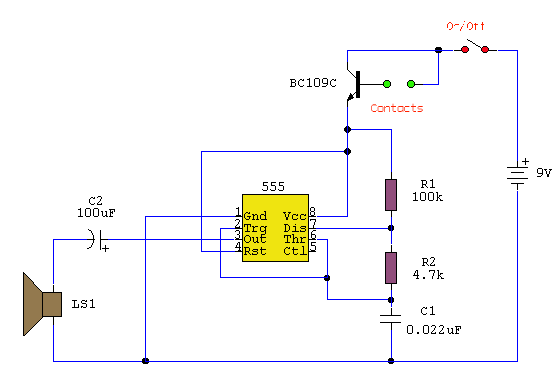
The circuit utilizes a 555 timer configured as an astable oscillator and is powered by the emitter current of the BC109C transistor. In dry conditions, the transistor does not receive bias current and remains fully off. When the probes become wet, a small current flows between the base and emitter of the transistor, causing it to turn on. This results in a larger current flowing through the collector circuit, which activates the 555 oscillator to produce sound. An On/Off switch is included, and it is important to use non-reactive metals for the probe contacts. Gold or silver-plated contacts from an old relay can be utilized, but an economical alternative is to use alternating copper strips from a piece of veroboard. Although these may oxidize over time, the minimal current in the base circuit means that the increased impedance from oxidation is not significant. No base resistor is required since the transistor operates in an emitter follower configuration, with the current limited by the impedance at the emitter, which is part of the oscillator circuit.
The described circuit employs a 555 timer in an astable configuration, which generates a continuous square wave output. This output is used to drive a speaker or other sound-producing device, creating an audible signal when the circuit is activated. The BC109C transistor acts as a switch, controlling the flow of current based on the moisture detected by the probes.
The probes are designed to detect changes in resistance caused by moisture, which allows for the activation of the transistor. When the probes are dry, the base-emitter junction of the transistor remains reverse-biased, preventing current flow. As moisture bridges the gap between the probes, a small current is allowed to flow into the base, turning the transistor on. This transition enables a larger current to flow from the collector to the emitter, powering the 555 timer and producing sound.
The inclusion of an On/Off switch provides a means to control the circuit's operation manually, allowing for easy activation or deactivation as needed. The choice of materials for the probe contacts is critical, as reactive metals may corrode and affect circuit performance. Gold or silver plating is preferred due to their resistance to oxidation, ensuring reliable operation over time. The use of copper strips presents a cost-effective solution, although they may require periodic replacement due to oxidation.
In summary, the circuit is a simple yet effective moisture detection system that utilizes a 555 timer and a transistor to produce an audible alert when moisture is detected. The design is straightforward, with considerations for component selection and circuit operation that ensure reliable performance in varying environmental conditions.The circuit uses a 555 timer wired as an astable oscillator and powered by the emitter current of the BC109C. Under dry conditions, the transistor will have no bias current and be fully off. As the probes get wet, a small current flows between base and emitter and the transistor switches on.
A larger current flows in the collector circuit enabling the 555 osillator to sound. An On/Off switch is provided and remember to use a non-reactive metal for the probe contacts. Gold or silver plated contacts from an old relay may be used, however a cheap alternative is to wire alternate copper strips from a piece of veroboard. These will eventually oxidize over but as very little current is flowing in the base circuit, the higher impedance caused by oxidization is not important.
No base resistor is necessary as the transistor is in emitter follower, current limit being the impedance at the emitter (the oscillator circuit). 🔗 External reference
The described circuit employs a 555 timer in an astable configuration, which generates a continuous square wave output. This output is used to drive a speaker or other sound-producing device, creating an audible signal when the circuit is activated. The BC109C transistor acts as a switch, controlling the flow of current based on the moisture detected by the probes.
The probes are designed to detect changes in resistance caused by moisture, which allows for the activation of the transistor. When the probes are dry, the base-emitter junction of the transistor remains reverse-biased, preventing current flow. As moisture bridges the gap between the probes, a small current is allowed to flow into the base, turning the transistor on. This transition enables a larger current to flow from the collector to the emitter, powering the 555 timer and producing sound.
The inclusion of an On/Off switch provides a means to control the circuit's operation manually, allowing for easy activation or deactivation as needed. The choice of materials for the probe contacts is critical, as reactive metals may corrode and affect circuit performance. Gold or silver plating is preferred due to their resistance to oxidation, ensuring reliable operation over time. The use of copper strips presents a cost-effective solution, although they may require periodic replacement due to oxidation.
In summary, the circuit is a simple yet effective moisture detection system that utilizes a 555 timer and a transistor to produce an audible alert when moisture is detected. The design is straightforward, with considerations for component selection and circuit operation that ensure reliable performance in varying environmental conditions.The circuit uses a 555 timer wired as an astable oscillator and powered by the emitter current of the BC109C. Under dry conditions, the transistor will have no bias current and be fully off. As the probes get wet, a small current flows between base and emitter and the transistor switches on.
A larger current flows in the collector circuit enabling the 555 osillator to sound. An On/Off switch is provided and remember to use a non-reactive metal for the probe contacts. Gold or silver plated contacts from an old relay may be used, however a cheap alternative is to wire alternate copper strips from a piece of veroboard. These will eventually oxidize over but as very little current is flowing in the base circuit, the higher impedance caused by oxidization is not important.
No base resistor is necessary as the transistor is in emitter follower, current limit being the impedance at the emitter (the oscillator circuit). 🔗 External reference
